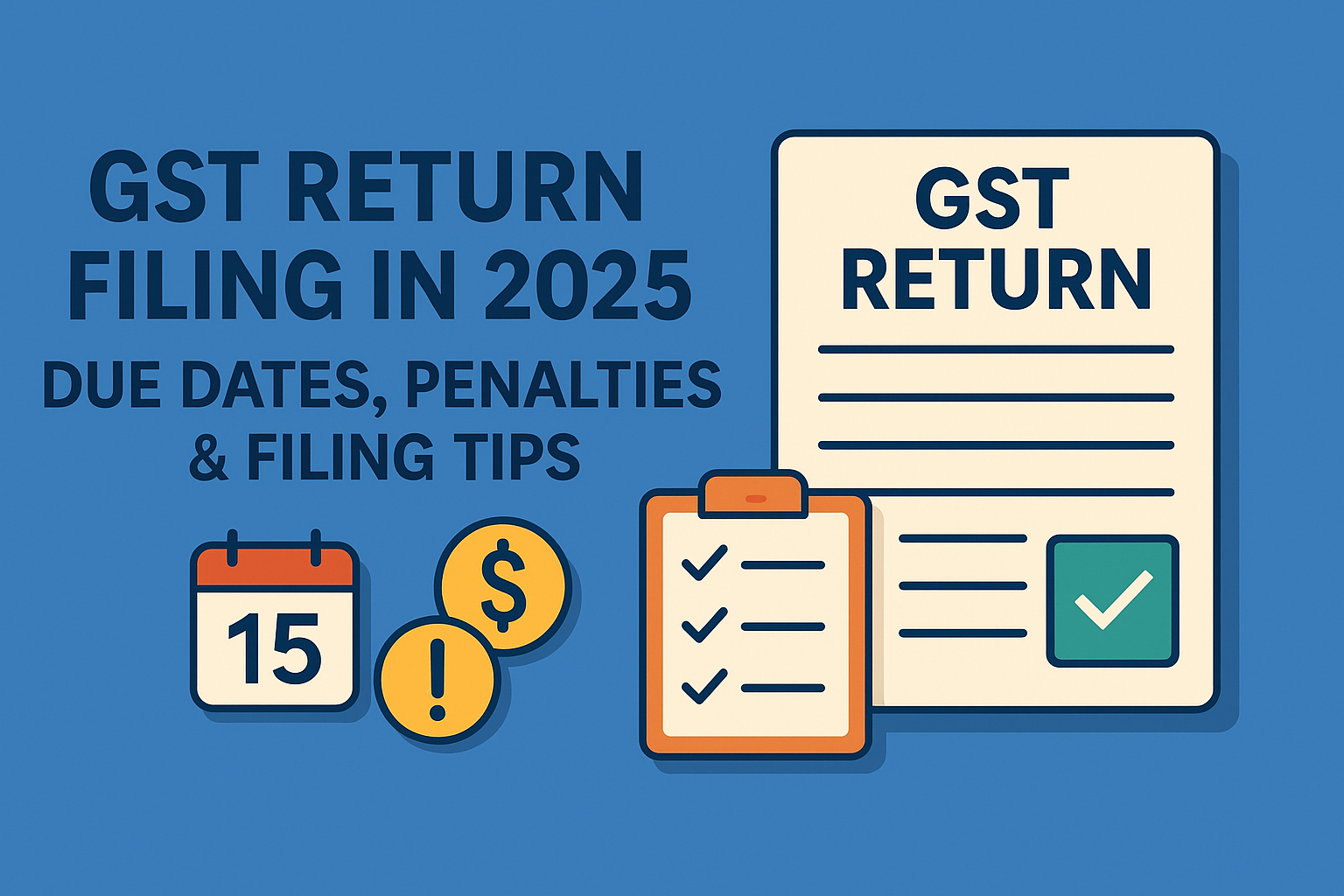
GST (Goods and Services Tax) continues to be a cornerstone of India’s indirect tax system. As we move into 2025, businesses—especially MSMEs and startups—must stay updated on GST return filing deadlines, penalties, and new compliance practices to avoid legal and financial complications.
In this comprehensive blog, we’ll walk you through GST return due dates, penalties for late filing, a step-by-step return filing guide, and pro tips to make your GST journey smoother in 2025.
📅 GST Return Filing Due Dates in 2025
GST returns must be filed monthly, quarterly, or annually based on the taxpayer’s turnover and return type. Below is the updated GST Calendar 2025 with important return types and their deadlines.
🗓️ GST Calendar Table 2025
| Return Type | Description | Frequency | Due Date (Every Month/Quarter) |
|---|---|---|---|
| GSTR-1 | Outward supplies report | Monthly/Quarterly | 11th of next month |
| IFF | Invoice Furnishing Facility | Optional (QRMP) | 13th of next month (1st & 2nd month of quarter) |
| GSTR-3B | Summary return & tax payment | Monthly/Quarterly | 20th (Monthly), 22nd/24th (QRMP) |
| GSTR-4 | Composition scheme taxpayers | Annually | 30th April |
| GSTR-9 | Annual return | Annually | 31st December |
| GSTR-9C | Reconciliation statement | Annually | 31st December |
Pro Tip: Use GST calendar apps or Google Calendar reminders to avoid missing dates.
💸 Penalties and Late Fees for Delayed Filing
Failing to file returns on time leads to penalties and interest, which could financially strain your business.
✅ Late Fee Details:
- ₹50/day (₹25 CGST + ₹25 SGST) for GSTR-1 and GSTR-3B
- ₹20/day for NIL returns (₹10 CGST + ₹10 SGST)
- Capped at ₹5,000 per return
✅ Interest on Late Payment:
- 18% per annum on outstanding tax amount
- 24% for excess ITC claimed or reduced output tax liability
📝 How to File GST Returns in 2025 (Step-by-Step Guide)
Here’s a simple breakdown of the GST return filing process:
- Login to the GSTN Portal
- Choose the appropriate return form (GSTR-1, GSTR-3B, etc.)
- Enter invoice details or upload JSON from your accounting software
- Validate & reconcile ITC with GSTR-2B
- Make payment if any tax is due
- Submit and file with DSC or EVC
⚠️ Common Mistakes to Avoid While Filing
Avoid these errors to prevent notices and audits:
- Entering incorrect HSN/SAC codes
- Mismatch between GSTR-1 and GSTR-3B
- Ignoring GSTR-2B reconciliation
- Forgetting NIL return submission
- Missing quarterly invoices for QRMP scheme users
💼 Best Practices for GST Return Filing
Ensure smooth GST compliance using these expert practices:
- Use automated GST filing software (like Tally, ClearTax, Zoho Books)
- Reconcile ITC every month with GSTR-2B
- File NIL returns even if there are no transactions
- Schedule reminders or alerts for due dates
- Avoid manual data entry errors
📊 GST Filing for Small Businesses and MSMEs
Under the QRMP (Quarterly Return Monthly Payment) scheme:
- Businesses with turnover < ₹5 crore can opt for quarterly filing
- Use IFF to upload invoices monthly
- Less burden, fewer filings, and no penalty if filed quarterly within timelines
🔄 Latest GST Updates in 2025
Stay informed with the latest regulatory changes:
- E-invoicing mandatory for businesses with turnover > ₹5 crore
- Auto-population of GSTR-3B from GSTR-1 & GSTR-2B
- AI-based scrutiny tools integrated by GSTN for red flags
- Revised interest rates and late fee waivers (if any announced)
❓FAQs: GST Return Filing in 2025
Q1. What is the last date to file GSTR-3B for January 2025?
20th February 2025 (Monthly); 22nd/24th (QRMP)
Q2. Can I revise a GST return after submission?
No. You need to make adjustments in the next return period.
Q3. Is there a penalty for late NIL returns?
Yes. ₹20 per day (CGST+SGST)
Q4. What happens if I don’t file GST for 6 months?
GST registration may be suspended or cancelled.
✅ Conclusion
Timely GST return filing is not just about avoiding penalties—it’s about ensuring smooth business operations and ITC claims. With the changing GST landscape in 2025, it’s vital to follow best practices, use automation tools, and always stay updated.




